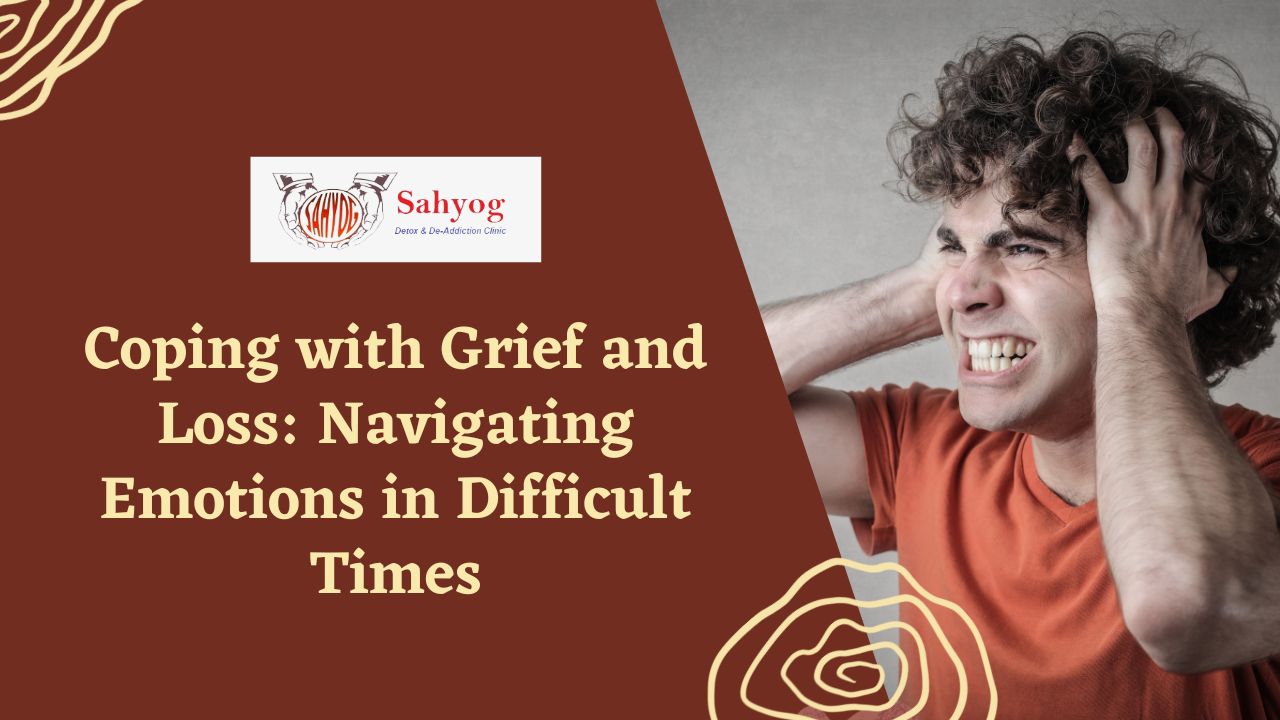Coping with Grief and Loss: Navigating Emotions in Difficult Times
Dealing with grief and loss is undoubtedly one of life’s most challenging journeys. Whether it’s the passing of a loved one, the end of a relationship, or the loss of something we hold dear, navigating through these emotions can feel overwhelming. Coping with grief requires strength, patience, and understanding as we learn to process our feelings and find ways to heal. In this blog post, we will explore different types of grief, delve into the stages of grieving, and provide practical tips on how to cope with grief and loss. If you’ve been struggling to navigate your emotions during difficult times, keep reading – because healing is possible!
The Different Types of Grief
When it comes to grief, it’s important to recognize that there is no one-size-fits-all experience. Grief can manifest in different ways for different people, and understanding the various types of grief can help us navigate our own emotions and support others who may be going through a difficult time.
One type of grief that many are familiar with is anticipatory grief. This occurs when we know in advance that we will experience a loss, such as when a loved one has been diagnosed with a terminal illness. Anticipatory grief allows us to begin processing our emotions before the actual loss occurs, but it doesn’t make the subsequent grieving process any less painful.
Another type of grief is complicated or prolonged grief. This refers to an extended period of intense mourning that may prevent individuals from moving forward in their lives. Complicated grief often involves feelings of guilt or anger and may require professional support to work through.
Ambiguous loss is yet another form of grieving that can be particularly challenging. It occurs when there is no clear closure or resolution surrounding a loss, such as when someone goes missing or is estranged from their family. The lack of answers or certainty makes this type of grief complex and ongoing.
Grief also extends beyond the death of a loved one; it can encompass other losses as well, such as divorce, job loss, or even the end of significant relationships. These types of non-death-related losses are referred to as disenfranchised grief because they may not receive societal recognition or validation compared to bereavement after death.
Understanding these different types of grief helps us recognize that everyone’s journey through loss will be unique and deeply personal. By acknowledging this diversity within the grieving process, we can approach ourselves and others with compassion and empathy during difficult times without minimizing anyone’s pain or experiences.
The Stages of Grief
Grieving is a complex process that involves navigating through different stages. These stages are not linear and may occur in any order, with individuals experiencing each stage differently. It’s important to remember that everyone grieves uniquely, and there is no right or wrong way to go through these stages.
One of the most recognized models for understanding the stages of grief is the Kübler-Ross model. This model suggests that there are five main stages: denial, anger, bargaining, depression, and acceptance. However, it’s essential to note that not everyone will experience all these stages or in the same intensity.
Denial often serves as a protective mechanism initially when faced with loss. It can be challenging to accept and acknowledge the reality of what has happened. As time goes on, denial typically gives way to feelings of anger. Anger can be directed towards oneself, others involved in the situation, or even towards life itself.
Bargaining comes next – an attempt to regain control by making deals with a higher power or trying to negotiate an alternative outcome. Depression then sets in as reality sinks in further, leading to overwhelming sadness and despair. Acceptance gradually emerges as individuals begin coming to terms with their loss and start adjusting without feeling consumed by grief.
It’s critical to understand that these stages are not set in stone; they serve more as guidelines rather than strict progression markers for every individual’s grief journey.
How to Cope with Grief and Loss
One of the most important things to remember when coping with grief and loss is to allow yourself to feel whatever emotions come up. It’s natural to experience a wide range of feelings, from sadness and anger to confusion and even guilt. Don’t try to suppress or ignore these emotions; instead, give yourself permission to fully experience them.
Finding healthy ways to express your emotions can be incredibly helpful in navigating through difficult times. This could involve talking with a trusted friend or family member, writing in a journal, or engaging in activities that bring you joy and help you process your feelings.
Taking care of your physical well-being is also essential when dealing with grief and loss. Make sure you’re getting enough rest, eating nutritious foods, and exercising regularly. Engaging in self-care activities such as taking walks in nature, practicing meditation or deep breathing exercises can also provide comfort during this challenging time.
Seeking support from others who have experienced similar losses can be immensely beneficial as well. Consider joining a support group where you can share your thoughts and feelings openly without judgment. Connecting with others who understand what you’re going through can offer validation, empathy, and valuable insights on how they coped with their own grief journey.
It’s important not to rush the grieving process or put pressure on yourself for healing at a certain pace. Grief takes time – there is no set timeline for recovery – so be patient with yourself throughout this journey.
Remember that it’s okay if some days are harder than others; grief often comes in waves. Be gentle with yourself during those tough moments by practicing self-compassion and allowing space for healing.
Coping with grief and loss involves acknowledging your emotions without judgment, finding healthy outlets for expression, taking care of your physical well-being while seeking support from loved ones or professional resources if needed. Above all, remember to be patient and kind to yourself throughout this process.
Tips for Navigating Emotions in Difficult Times
When we are faced with grief and loss, it can feel like our emotions are spinning out of control. It’s important to remember that it’s okay to feel a wide range of emotions during this time. Here are some tips to help you navigate your emotions in difficult times.
Allow yourself to grieve. Give yourself permission to feel whatever emotions come up for you. Whether it’s sadness, anger, or confusion, know that these feelings are normal and part of the healing process.
Don’t be afraid to reach out for support. Talk to friends or family members who can provide a listening ear or seek professional help if needed. Sharing your thoughts and feelings with others can lighten the burden on your shoulders.
Another helpful tip is practicing self-care. Take care of yourself physically and mentally by engaging in activities that bring you joy and relaxation. This could include exercise, meditation, journaling, or spending time in nature.
Additionally, be patient with yourself as you go through the grieving process. Healing takes time and everyone moves at their own pace. Don’t rush your emotions or expect them to disappear overnight; give yourself grace as you navigate this journey.
Find healthy coping mechanisms that work for you personally. This could involve expressing your feelings through art or music therapy, joining support groups where others understand what you’re going through or finding solace in spiritual practices such as prayer or mindfulness techniques.
Remember that navigating emotions during difficult times can be challenging but also an opportunity for growth and self-discovery. Be kind to yourself along the way as you heal from grief and loss.
Grieving process worksheet
Grieving Process Worksheet: A Tool for Honoring Your Emotions
Navigating through grief and loss can feel overwhelming at times. It’s normal to experience a flood of emotions that may seem impossible to untangle. That’s where a grieving process worksheet can be beneficial.
A grieving process worksheet is a helpful tool that allows you to explore your emotions and thoughts in a structured way. It provides prompts and space for reflection, enabling you to honor your feelings and gain clarity during difficult times.
One section of the worksheet might ask you to list specific memories or moments that bring up strong emotions related to your loss. This exercise encourages you to acknowledge the impact of these experiences on your grief journey.
Another section might prompt you to identify any unresolved issues or unfinished conversations with the person you have lost. By addressing these lingering thoughts, it allows for closure in some capacity.
Additionally, a grieving process worksheet often includes space for writing down any regrets or guilt surrounding the loss. This exercise encourages self-compassion as it reminds us that we are only human and cannot control every aspect of life.
Furthermore, the worksheet may guide you in exploring coping strategies that have been effective for managing your grief thus far. It prompts self-reflection on what has worked well in terms of finding support, practicing self-care, and allowing yourself time to heal.
Remember, there is no right or wrong way to use a grieving process worksheet — it’s simply meant as an avenue for processing complex emotions associated with loss. Take your time completing each section at your own pace; this is about honoring yourself during this challenging period rather than rushing through it.
Conclusion
Navigating grief and loss can be an incredibly challenging and deeply personal journey. Whether you’re experiencing the loss of a loved one, a job, or any other significant change in your life, it’s important to remember that grief is a natural response to loss.
By understanding the different types of grief and familiarizing yourself with the stages of grief, you can begin to make sense of your emotions and find ways to cope. It’s essential to give yourself permission to grieve and take the time you need for healing.
Remember that everyone experiences grief differently, so don’t compare your journey to others’. Take care of yourself physically, emotionally, and mentally during this difficult time. Seek support from friends, family members, or professional counselors who can provide guidance as you navigate through your emotions.
Practice self-compassion and allow yourself moments of joy amidst the sorrow. Engage in activities that bring you comfort and solace – whether it’s spending time in nature, journaling your thoughts and feelings, or participating in creative outlets such as art or music therapy.
Remember that healing takes time. Be patient with yourself as you gradually adjust to life without what was lost. Allow space for both ups and downs along the way but always hold onto hope that brighter days will come.
While coping with grief may seem overwhelming at times if approached with patience and self-care strategies mentioned above – navigating through these difficult emotions becomes more manageable over time.
Let us honor our losses by acknowledging our pain while also embracing opportunities for growth in our lives after experiencing profound loss. Remember: You are not alone on this journey towards healing!


